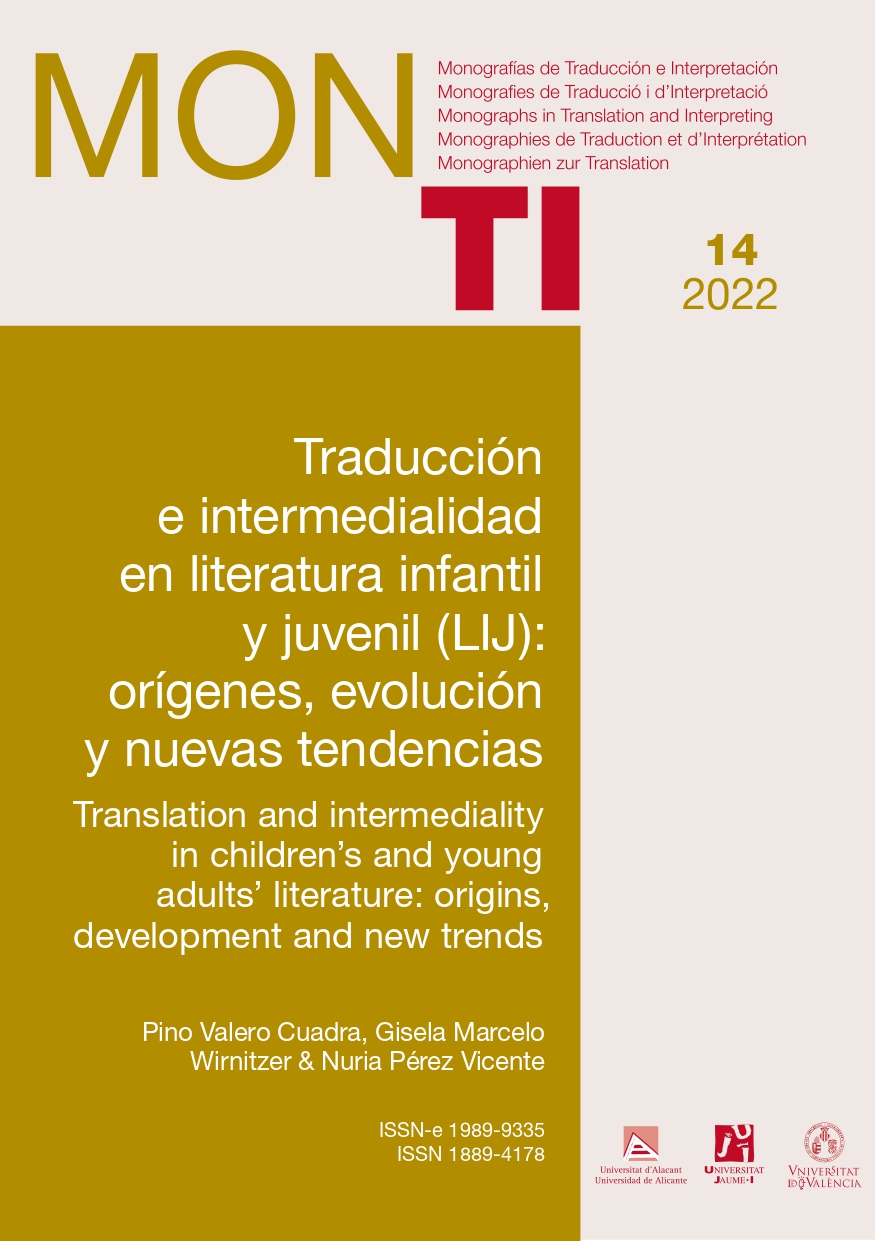From the book to television and to the whole world. Maya the Bee in Basque
Contenido principal del artículo
Resumen
The aim of this article is to show how the Maya the Bee franchise entered the Basque cultural system and, more specifically, how the audiovisual translation (AVT) into Basque was conducted. Maya the Bee is a character from a book written by the German author Waldemar Bonsels in 1912. Yet, her origins are not that well known, as she made her entrance into the public consciousness more recently through audiovisual media. The first two sections of the article delve both into the origins and the multimedia character of Maya the Bee. The third section of the article focuses on the introduction of the Maya franchise into the Basque cultural system, the fourth section explains the methodology used and the fifth section presents the results of an analysis of the AVT. The analysis focuses on the dubbing of the 3D series (English into Basque) and looks at whether both nature-related terms are simplified and offensive language and wordplay have been retained.
Descargas
Detalles del artículo
La propiedad intelectual de los artículos pertenece a los autores y los derechos de edición y publicación, a la revista. Los artículos publicados en la revista podrán ser usados libremente para propósitos educativos y científicos, siempre y cuando se realice una correcta citación del mismo. Cualquier uso comercial queda expresamente penado por la ley.
Citas
ASPURU, Aitor. (2019) “Son Gokuk euskararen alde borrokatu zuenean gaztelera garaitu arte: euskara, marrazki bizidunak eta globalizazioa.” Argia 20/02/2016. Online version: <https://www.argia.eus/albistea/son-gokuk-euskararen-alde-borrokatu-zuenean-gaztelera-garaitu-arte-euskara-marrazki-bizidunak-eta-globalizazioa>
BARAMBONES, Josu. (2009) La traducción audiovisual en ETB-1: un estudio descriptivo de la programación infantil y juvenil. Bilbao: UPV.
BARAMBONES, Josu. (2012) Mapping the dubbing scene. Audiovisual translation in Basque television. Bern: Peter Lang.
CHAUME, Frederic. (2013) “The turn of audiovisual translation: New audiences and new technologies.” Translation Spaces 2:1, pp. 105-123.
EWERS, Hans-Heino. (2006) “Die Heldensagen der Gegenwart. Die Medienverbundangebote sind die groβen Narrationen unserer Zeit.” In: Garbe, Christine & Philipp, Maik. (eds.). 2006. Harry Potter, ein Literatur-und Medienereignis in Blickpunkt interdisziplinärer Forschung. Hamburg: LitVerlag, pp. 297-311.
GÖHLEN, Joseph. (2014) “Maja – Alle lieben Maja.” In: Weiß, Harald (ed.). 2014. 100 Jahre Biene Maja – Vom Kinderbuch zum Kassenschlager. Heidelberg: Winter, pp. 133-142.
HACH EMBAREK, Beñat. (2019) “Beñat Muguruza: Erronka handi bat zagok euskara batuaren eta hitanoaren uztarketan.” Zuzeu 18/06/2019. Online version: <https://zuzeu.eus/euskara/benat-muguruza>
HATIM, Basil & Ian Mason. (1992) Discourse and the translator. New York &London: Longman.
HENGST, Heinz. (2014) “Am Anfang war die Biene Maja. Medienverbund und Japanisierung der kommerziellen Kultur.” In: Weiß, Harald (ed.). 2014. 100 Jahre Biene Maja – Vom Kinderbuch zum Kassenschlager. Heidelberg: Winter, pp. 143-165.
KIRSCHKE, Wolfgang. (2012) “Auch eine deutsche Bildungsgeschichte.” Frankfurter Allgemeine Zeitung 28/06/2012. Online version: <https://www.faz.net/aktuell/feuilleton/buecher/100-jahre-biene-maja-auch-eine-deutsche-bildungsgeschichte-11799884.html>
KÜMERLING-MEIBAUER, Bettina. (2014) “Nicht nur “Ein Märchen für Kinder”. Die Biene Maja als Crossover Literatur.” In: Weiß, Harald (ed.). 2014. 100 Jahre Biene Maja – Vom Kinderbuch zum Kassenschlager. Heidelberg: Winter, pp. 45-63.
LEVEQUE, Mathilde. (2013) “Relire Maïa l’abeille aujourd’hui.” Strenæ 5. https://doi.org/10.4000/strenae.1005
LEVEQUE, Mathilde. (2021) “A abelha Maia, um clássico alemão em França.” In: Fragoso, Gabriela (ed). 2021. Três clássicos da literatura infantojuvenil: Bambi-Heidi-Abelha Maia. Lisboa: Universidade Católica de Lisboa, pp. 106-118.
MANTEROLA, Elizabete. (2012) Euskal literatura beste hizkuntza batzuetara itzulia. Bernardo Atxagaren lanen itzulpen moten arteko alderaketa. Bilbao: UPV.
MARTI FERRIOL, José Luis. (2010) Cine independiente y traducción. València: Tirant lo Blanch.
MARTÍNEZ LORENZO, Mercedes. (2020) “La accesibilidad a los medios y las lenguas minorizadas: estado de la cuestión del subtitulado para sordos (SpS) en la televisión de Galicia (TVG).” In: Waluch de la Torre, Edyta et al. (eds.). Las lenguas ibéricas en la traducción y la interpretación. Warzawa: Biblioteka Iberyjska, pp. 225-249.
MARZÀ, Anna. (2009) “La traducció audiovisual de l’animació a RTVV.” In: AELC (ed). 2009. XVI Seminari sobre la Traducció a Catalunya. Còmic, manga i conte il·lustrat. Barcelona: AELC, pp. 31-49.
MARZÀ, Anna. (2016) La naturalitat en la traducció per al doblatge. El cas dels marcadors d’intensificació. Castelló de la Plana: Universitat Jaume I.
MATAMALA, Anna. (2009) “La traducció de productes d’animació per a doblatge en català.” In: AELC (ed.) 2009. XVI Seminari sobre la Traducció a Catalunya. Còmic, manga i conte il·lustrat. Barcelona: AELC, pp. 49-71.
MUGURUZA, Beñat & Garbiñe Bereziartua. (2021) “Dragon Ball on the Basque public TV: influence on viewer’s language attitudes and practices.” Journal of Multilingual and Multicultural Development NÚMERO, pp. PÁGINAS. DOI: <10.1080/01434632.2021.1946547>
PRAT, Ana. (2014) Estudi descriptiu i comparatiu del model de llengua del doblatge al català: el cas de les sèries d’animació i d’anime al sistema televisiu balear. Castelló de la Plana: Universitat Jaume I.
O’CONNELL, Eithne. (2003) Minority Language Dubbing for Children. Screen Translation from German to Irish. Bern: Peter Lang.
SARASOLA, Ibon & Pello Salaburu. (2021) Egungo Testuen Corpusa (ETC). Online version: <https://www.ehu.eus/etc/>
WAJNRYB, Ruth. (2005) Expletive deleted. A good look at bad language. New York: Free Press.
WEIß, Harald. (2014a) “Einleitung.” In: Weiß, Harald (ed.). 2014. 100 Jahre Biene Maja – Vom Kinderbuch zum Kassenschlager. Heidelberg: Winter, pp. 7-19.
WEIß, Harald. (2014c) “Maja, Shakespeare und Herr Goebbels.” In: Weiß, Harald (ed.). 2014. 100 Jahre Biene Maja – Vom Kinderbuch zum Kassenschlager. Heidelberg: Winter, pp. 109-132.
WEIß, Harald. (2014b) “Vergöttert und vergessen: Der Autor der Biene Maja.” In: Weiß, Harald (ed.). 2014. 100 Jahre Biene Maja – Vom Kinderbuch zum Kassenschlager. Heidelberg: Winter, pp. 21-43.
YÉBENES, Pilar. (2002) Cine de animación en España. Barcelona: Ariel Cine.
ZUBILLAGA, Naroa. (2015) “(In)direct offense. A comparison of direct and indirect translations of German offensive language into Basque.” Perspectives 24:3, pp. 486-497


